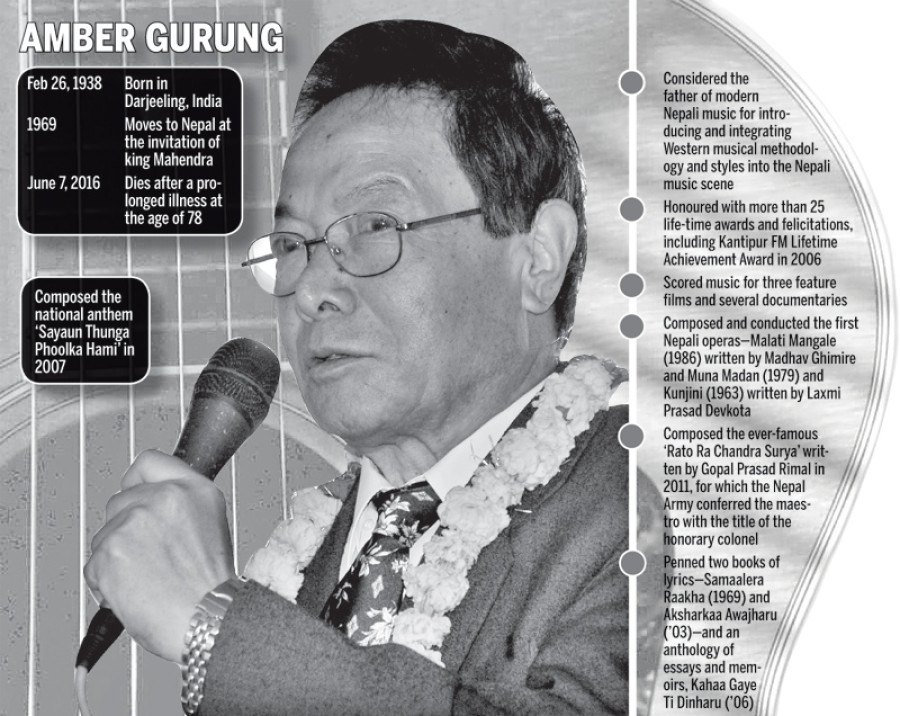Miscellaneous
A giant among composers passes away
When Agam Singh Giri, a Darjeeling schoolteacher, handed Amber Gurung a page of lyrics in 1960, little did either know that they were about to set in motion a chain of events that would alter their lives, careers and the then still-evolving Nepali musical landscape.
Sanjit Pradhananga
When Agam Singh Giri, a Darjeeling schoolteacher, handed Amber Gurung a page of lyrics in 1960, little did either know that they were about to set in motion a chain of events that would alter their lives, careers and the then still-evolving Nepali musical landscape.
The song, Nau Lakh Tara, would go on to infuriate Indian authorities who promptly labelled it “anti-national”, even as it became an emblematic tune for Nepali listeners, in both Nepal and India. It would also be the break that Gurung, an aspiring musician and a music teacher at the time, had been looking for.
Amber Gurung’s illustrious musical career drew to a close in the early hours of Tuesday at the Grande International Hospital where he was undergoing treatment for diabetes, Parkinson’s disease and high blood pressure.
The music maestro, recently developed severe pneumonia and bleeding of upper gastrointestinal tract, said Dr Chakra Raj Pandey, director of Grande International Hospital. Gurung passed away at 2:37am.
His body was kept at Nepal Academy in the afternoon where thousands of music lovers and well wishers paid their last tribute. His final rites were performed at Pashupati Aryaghat with full state honours in the evening.
Gurung was born in 1938 in Darjeeling, India where his father, Ujir Singh Gurung, was stationed with the British India police force. Passionate about music from an early age, the singer was already winning acclaims and awards for his compositions while in school. Well-versed in both Western and Eastern musical styles, Gurung taught himself to play a host of instruments including the violin, tabala and mandolin.
Following his graduation from Turnbull School, Darjeeling, Gurung initiated the Art Academy of Music from a classroom at local Bhanubhakta School—where he crossed paths with budding musicians including Gopal Yonzon and Aruna Lama. It was here that he met Giri, the school’s headmaster, before they collaborated on the era-defining Nau Lakh Tara.
After the tune gained immense popularity in Darjeeling and beyond—winning him both fans and detractors—Gurung extensively toured cities in India and Nepal. He was then invited by king Mahendra to chair the music department of the newly formed Nepal Academy of Arts in 1968. He held the position for 30 years and used his tenure to revitalise folk and ethnic music.
In the decades that followed, he would go on to compose well over 1,000 songs including hits like Rato Ra Chandra Surya and Jindagiko Ke Kura.
In a conversation with the Post, musician Aavash, Gurung’s long standing student and collaborator, lauded his guru’s invaluable contribution to Nepali music.
“Before Amber Gurung (and his contemporaries) modern Nepali music had not evolved yet. They should be credited for fusing Western genres with the musical landscape here, which in turn helped carve a tone that was unique to Nepal,” he said. It is an assessment accepted ubiquitously within the Nepali music industry.
During a career that spanned over five decades, Gurung would go on to be conferred with over two dozen lifetime achievement awards including the Jagdambashree Award in 1998, Hits FM Lifetime Achievement Award in 2001 and the Kantipur FM Lifetime Achievement Award in 2006.
He also penned two books of lyrics and memoirs—Samaalera Raakha (1969), Akcharkaa Awajharu (2003), and an anthology of essays and memoirs, Kahaa Gae Ti Dinharu (2006), for which he won the 2007 Uttam Shanti Sahitya Puraskar.
By the mid-2000s, Gurung’s long career was winding down under the weight of several physical ailments. Following the end of the monarchy, however, he was invited by the government to sit on the panel that would select a new national anthem for the newly declared federal democratic republic of Nepal. Gurung would himself lend his music to Sayuan Thunga which was selected from 1,272 different entries.
Byakul Maila, the lyricist of the anthem, remembered Gurung as a prolific musician who never let fame or acclaim get to his head.
“He was an incredibly humble human being. Even after the anthem was adopted, he was always careful not to hog the limelight,” Maila told the Post. He went on to describe how Gurung had devised 14 different variations for the anthem, but insisted that the lyricist help him pick the final three versions that would be submitted to the government.
“Despite the fact that I was not from a musical background, he wanted my input,” Maila recalled. He was one of the thousands of fans and well-wishers who took to social media platforms to express their sadness over Gurung’s death. “He was born to serve Nepali music, and that is what he dedicated his life to,” the lyricist wrote.
With his passing, fans were quick to reiterate that it marked the end of a glorious era of which Gurung, Narayan Gopal and Gopal Yonzon were the stalwarts. As a fan aptly summed it, “Nepal will never forget Amber Gurung. Tonight Nau Lakh Taras, and more, will be out mourning.”
"Amber Gurung would always shine as a never-fading star. Nepal and Nepali people will always be indebted to him for his enormous contribution" - KP Sharma Oli, Prime Minister
"With the demise of Amber Gurung, Nepal’s music fraternity has lost a guardian" - Sher Bahadur Deuba, President, NC
"Before Amber Gurung (and his contemporaries), modern Nepali music had not evolved yet. They should be credited for fusing Western genres with the musical landscape here" - Aavash, Gurung’s student
"Amber Gurung was an incredibly humble human being. Despite the fact that I was not from a musical background, he would ask for my inputs while composing the anthem" - Byakul Maila, lyricist, national anthem




 7.12°C Kathmandu
7.12°C Kathmandu










